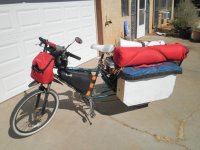mynameisfiber
100 µW
- Joined
- Sep 22, 2018
- Messages
- 8
Hey All,
So, I finally decided to build an ebike. I've never owned one, so I think some of my questions come from a fundamental lack of knowledge. That being said, I'm very excited to learn and have already read so much about everything!
Anyway, I want to build a bike that is _mainly_ for long distance touring, but will also work for trips to the beach or that really good restaurant your friend tells you about that is conveniently outside of metro service. I also will always be pedaling and am not looking for a throttle experience... I love biking and am seeing a motor as a way to extend the distances I can comfortably go and flatten out those pesky hills.
For long distance trips I would like to pull at least 100mi/day (120-140 would be ideal) on cycleways and some crushed limestone trails. I don't mind planning to charge every night, but I wouldn't complain if I had even more range . For more day-to-day use, I'm probably doing about 20-40mi roundtrip on asphalt.
. For more day-to-day use, I'm probably doing about 20-40mi roundtrip on asphalt.
I haven't decided which bike to build this on yet. I'm thinking I'm going to first select the motor/battery arrangements so I can find a bike that'll fit. Whatever it is though, it'll probably be a classic touring bike.
Battery wise, I was thinking about doing two 48V 24Ah batteries in parallel when touring and one 48V 13Ah. In the far future, I'd like to modify things to also have a solar panel on board to help give extra range or potentially fully charge the system when I'm camping, but that is not an immediate concern.
Motor wise, I'm debating between the BBSHD and the TSDZ2 (I'm open to others, but those are the main ones I've seen in my research).
Main thoughts on the TSDZ2:
- the torque sensor which seems to be suited for people like me who like pedal assist (again, any experience here is welcome)
- here is some open firmware which I would love to hack on
- lower wattage means better range?
Main thoughts on the BBSHD:
- Seems to be a huge amount of community support
- High power seems appealing for large loads / big mountains (but will this hurt battery when on straightaways?)
- Marginal programming ability... it seems like this may expand in the future?
Anyway... any thoughts or experiences or links to successful touring builds would be very useful!
So, I finally decided to build an ebike. I've never owned one, so I think some of my questions come from a fundamental lack of knowledge. That being said, I'm very excited to learn and have already read so much about everything!
Anyway, I want to build a bike that is _mainly_ for long distance touring, but will also work for trips to the beach or that really good restaurant your friend tells you about that is conveniently outside of metro service. I also will always be pedaling and am not looking for a throttle experience... I love biking and am seeing a motor as a way to extend the distances I can comfortably go and flatten out those pesky hills.
For long distance trips I would like to pull at least 100mi/day (120-140 would be ideal) on cycleways and some crushed limestone trails. I don't mind planning to charge every night, but I wouldn't complain if I had even more range
I haven't decided which bike to build this on yet. I'm thinking I'm going to first select the motor/battery arrangements so I can find a bike that'll fit. Whatever it is though, it'll probably be a classic touring bike.
Battery wise, I was thinking about doing two 48V 24Ah batteries in parallel when touring and one 48V 13Ah. In the far future, I'd like to modify things to also have a solar panel on board to help give extra range or potentially fully charge the system when I'm camping, but that is not an immediate concern.
Motor wise, I'm debating between the BBSHD and the TSDZ2 (I'm open to others, but those are the main ones I've seen in my research).
Main thoughts on the TSDZ2:
- the torque sensor which seems to be suited for people like me who like pedal assist (again, any experience here is welcome)
- here is some open firmware which I would love to hack on
- lower wattage means better range?
Main thoughts on the BBSHD:
- Seems to be a huge amount of community support
- High power seems appealing for large loads / big mountains (but will this hurt battery when on straightaways?)
- Marginal programming ability... it seems like this may expand in the future?
Anyway... any thoughts or experiences or links to successful touring builds would be very useful!



